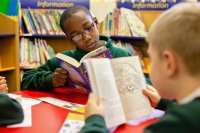If We Want Bookworms, We Need to Get Beyond Leveled Reading
When it comes to nurturing kids’ love of reading, research suggests variety, choice—and encouragement to stretch—can make a difference.
Your content has been saved!
Go to My Saved Content.Matching kids with “just right” books—texts they can read comfortably—has been the order of business for helping children learn to read for a long time. But some leading literacy and reading experts, writes Wayne D’Orio for School Library Journal, say this popular instructional approach, often called leveled reading, can be too limiting to turn out strong, independent readers who genuinely love reading and enjoy a rich variety of books.
“The general premise of leveled reading is that kids learn the most when they understand about 95 percent of a text’s words and score more than 75 to 80 percent on reading comprehension,” D’Orio writes. “Part of the appeal of matching readers to books on their level is that it seems like common sense, a Goldilocks fit. Students don’t get frustrated, and they are also more challenged than they would be by a book below their level.”
However, some critics say there are notable inconsistencies between how the different systems—the most widely adopted programs include Fountas and Pinnell, Lexile Framework for Reading, and the Accelerated Reader scale—rank some books. Twilight, for example, is recommended for early elementary readers by Lexile, but suggested for high school students by Fountas and Pinnell, and rated appropriate for fifth-grade readers by Accelerated Reader.
The major criticism about leveled reading, though, is that it unnecessarily narrows the scope of opportunity, reducing exposure to books that might surprise or challenge students. Leveling can pigeonhole kids at the same reading level for too long, preventing them from progressing to more difficult books as their reading skills improve throughout the school year. And when we perpetually match kids with “just right” books, D’Orio says, we dampen their enthusiasm to become independent browsers who desire—like most readers—to read at, above, and below their reading level at different times. We shouldn’t assume that a love of reading is inherent to children, or that it’s so durable we don’t need to be careful to nurture it.
“Leveling is an educational tool. It can be used well or used poorly,” clarifies Karen Yingling, a librarian at Blendon Middle School in Westerville, Ohio. It’s not that teachers need to stop using leveled reading—it’s that they need to be flexible in how they use it.
As schools build vibrant, culturally relevant collections of books for students, educators should be sure to provide students with an abundance of cultural, racial, and socioeconomic perspectives, and they should also cater to a wide variety of reading tastes across a broad range of reading levels, from books that are breezy reads to ones that pull students into unfamiliar and challenging territory.
Newer research is providing fresh insight—and a middle ground—for how to do a better job exposing readers to books like that. For example, starting in second grade, once students are past the decoding phase, literacy expert Tim Shanahan says, it’s helpful to periodically push students to read a bit above their reading levels.
But students should also have the discretion to read things they simply find enjoyable. Shanahan uses the metaphor of an athlete when he explains how teachers can encourage students to look beyond the rigid framework of leveled reading and develop an engaging, broad, and adventurous reading diet. “Top runners don’t train at one level: They take long runs, fast but shorter runs, and also can lift weights to build specific muscles,” Shanahan tells D’Orio. “Kids should read a wide range of texts, and libraries can help. They should read easy books to things that kick their butts. The variation of difficulty does matter.”
